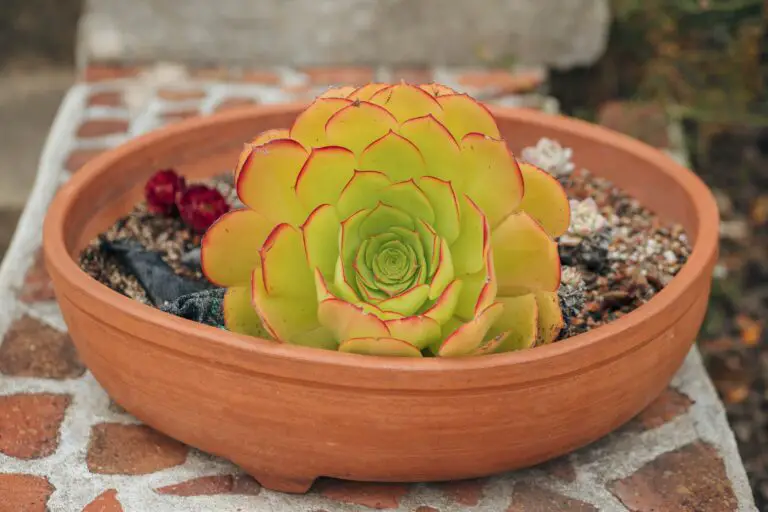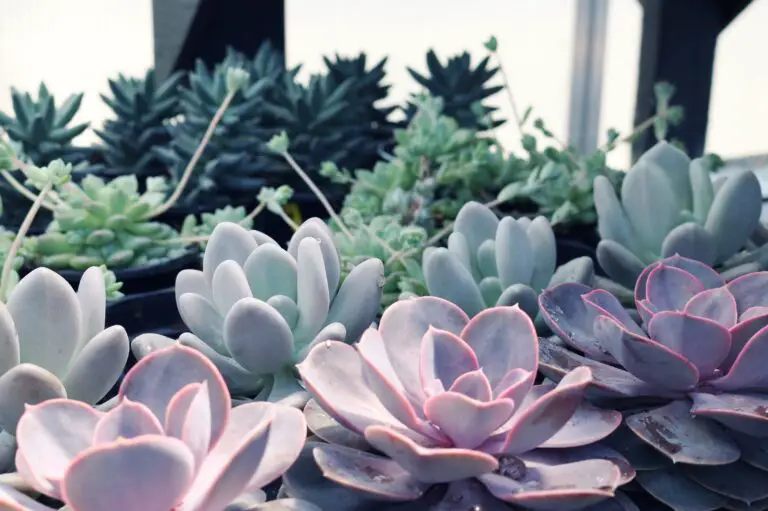Introduction to Echeveria
Welcome to the enchanting world of Echeveria, a genus that has charmed plant enthusiasts and casual admirers alike with its rosette splendor and intriguing variety. Picture this: a sun-kissed windowsill adorned with a collection of echeveria succulents, each a masterpiece of fleshy leaves poised in perfect symmetry – an unspoken testament to the allure of these botanical gems.
Why are these plants so popular, you ask? Well, imagine the delight of having an Echeveria ‘Lola’ bloom under your care, unveiling its opalescent leaves, or watching the ‘Perle von Nürnberg’ cast a purple hue that can make even the most stoic heart skip a beat. These are real moments, experiences shared by countless plant lovers around the globe, all thanks to the adaptable and low-maintenance nature of these succulents.
But it’s not all about looks; there’s a practical side to the Echeveria craze. In our fast-paced, high-stress lives, these plants are like a breath of fresh air, quietly teaching us the beauty of simplicity and resilience. On the care-front, they are forgiving and ask for little: just a bit of light, occasional water, and your admiring glances.

As we dive deeper into the succulent care basics later in this guide, remember that each Echeveria has its personality, a little living sculpture that adds a touch of green serenity to your space. They are not just plants; they are companions in your journey toward a zen-like nook in your home or office.
So, whether you’re a seasoned gardener or someone who’s just starting to walk the green path, the Echeveria genus welcomes you with open leaves. Get ready to explore the thriving tips that will ensure your succulent friends not only survive but flourish in the sunny spotlight of your life.
Understanding Light Needs for Succulents
When we consider the quintessential image of healthy succulents, what often comes to mind? Visions of happy Echeverias basking in generous sunlight, their colorful rosettes standing out like floral sunbursts. This isn’t mere fantasy; sunlight is the lifeblood of succulents, with Echeveria being no exception. But hold your sun hats, because the question on every succulent enthusiast’s lips is: does Echeveria need direct sunlight?
Let’s illuminate this matter. Sunlight isn’t just a “nice-to-have” for these plump-leafed beauties; it’s essential for two main reasons. Firstly, sunlight is the MVP in the game of photosynthesis. This process is like the plant version of a gourmet meal, where Echeverias convert light into the energy they need to grow and thrive. No sun, no photosynthesis, no stunning succulent display. It really is that critical.
Secondly, the right amount of sunlight gives Echeverias their vibrant hues and promotes robust health. When these succulents miss their sunbath, they start to etiolate—growing tall and thin, reaching out for more light. Their leaves lose vibrancy, turning a disheartened, pale green. It’s like watching a plant on a fruitless quest for its own sun-soaked nirvana.
In the natural habitats of these succulents, the direct sun is as omnipresent as the striking landscapes themselves. Imagine a rocky outcrop in the highlands of Mexico, where Echeverias grow wild and exposed, no stranger to baring their rosy faces to the bright sky above. However, in less sun-rich locales, or during gloomy winter months, finding that perfect lighting balance for indoor Echeverias can be a challenge. We need to mimic their native surroundings, giving them a taste of home with plenty of direct light, but without tipping over into the realm of sunburn—that’s right, succulents can get sunburned too!
If you’re wondering about the right soil for your sun-loving Echeverias, our guide to the best succulent soil mixes will point you in the right direction.
Your Echeveria’s light needs are non-negotiable. It craves that sunlight like early morning joggers crave their first sip of an energizing smoothie—eagerly and wholeheartedly. So, provide them with a well-lit south-facing window or use grow lights tailored for plants to simulate their sun-drenched dreams. And when you witness the richly pigmented, symmetrical splendor of your Echeveria flourishing, you’ll know those thriving tips have truly paid off.

Examining Echeveria’s Sunlight Requirements
Like a morning sun that greets the day, Echeveria plants invite a particular kind of light into their lives. It’s a love affair with the sun—part time at least. But don’t be misled; direct sunlight does not mean a scorching all-day buffet. Echeveria, with their rosette beauty and succulent charm, need a delicate balance between the sun’s embrace and the shade’s caress. Picture them basking in the soft morning glow, soaking up to around six hours of indirect sun followed by a gentle retreat from the midday intensity.
For instance, let’s say you’re living in a sun-drenched locale like California or the Mediterranean, where Echeveria can thrive outdoors. They can handle more direct light compared to their indoor-dwelling cousins. However, it’s a common misconception that these resilient plants are sun addicts. In reality, avoiding the midday peak can save them from a sunburn, which, yes, plants can get too! Instead, locate them where the light is like a gentle, filtered curtain; think of a spot under a sheer canopy or a lattice—a perfect stage for their performance. If you’re nurturing them inside, expert succulent care tips recommend a south or west-facing window that invites the sun but not its harsh midday penalties.
Adaptation is key; just as we put on sunglasses, Echeveria plants need their version of protection. This often comes in the form of acclimatization, a gradual welcoming of more sun to avoid shock. Imagine moving to a tropical island from a snowy town; your Echeveria needs the same considerate transition to sunnier locales. Patience is vital as you craft the perfect growth environment for these visual delights. And remember—therapeutic for us, selective sunlight is just as beneficial for Echeveria, nurturing their health and bringing out the boldest pigments in their leaves.
The Effects of Direct Sunlight on Echeveria
Imagine a rosette of fleshy leaves, vibrant and succulent, thriving under the golden rays of the sun. This image captures the essence of Echeveria, a plant that’s as beautiful as it is resilient. But does Echeveria need direct sunlight to showcase its splendor fully? Let’s dive into the world of these sun-loving beauties and understand the intricate dance between Echeveria and the fiery star above us.
Direct sunlight acts as a double-edged sword for Echeveria. On the one hand, it spurs growth, encourages rich coloration, and fortifies the plants against a bevy of pests. Picture an Echeveria basking in the morning light, its hues intensifying, a clear sign of a plant achieving its full potential. Yet, there’s a catch – too much direct sun, especially during the peak hours of the day, can lead to sunburn, a plant’s silent scream for mercy.
Real-life examples abound, illustrating the fine line that Echeveria enthusiasts must tread. Those living in areas with scorching summers often share tales of Echeveria with crisped edges, the aftermath of overexposure. On the flip side, indoor gardeners revel in the success of moving their Echeveria closer to a sunny window, observing a notable transformation from a lackluster green to a vibrant array of pinks and purples. It’s a testament to the adaptability of these succulents, provided they receive sunlight in moderation.
To give you a visual idea of what’s ideal for your Echeveria, let’s take a look at a video that perfectly captures the essence of sunlight interaction with these robust succulents:
Understanding the effects of direct sunlight on Echeveria is critical for ensuring your succulent doesn’t just survive, but thrives. Like crafting the perfect dish, it’s all about balance – giving your Echeveria just the right amount of direct sunlight to feast upon, while shielding it from the harsh midday rays that can spoil its splendor. Choose a spot that gets a few hours of gentle morning or late afternoon sun, and your Echeveria will reward you with a dazzling display that’s nothing short of spectacular.
How to Provide the Right Amount of Sunlight Indoors
Loving the sun but not the scorch, Echeveria plants are the sunshine connoisseurs of the succulent world! To keep your indoor Echeveria thriving, picture them like lazy cats basking in a cozy sunspot by the window—but not under the harsh midday beams. Just right is what they crave. Imagine setting up a reading nook where the warm light wraps around you, inviting you to lounge all afternoon with your favorite book. Your Echeveria, too, would relish a spot like this.
Here’s a real-life hack: place your Echeveria near an east or west-facing window. Morning sunlight is as gentle as a cool breeze, perfect for your succulent’s delicate skin. Think of that morning light as nature’s soft box—smooth, diffused, and dreamy. Same goes for the late afternoon rays, diluted and dappled, less likely to sunburn your little friend. But remember, direct high-noon light? That’s a no-go. It’s like being at a beach at midday without any sunscreen—ouch!
Don’t have that perfect sunny window ledge? No sweat! Creative indoor gardening has a plan B, and it comes with a plug — a grow light! With technology on your side, you can mimic those ideal sunbathing conditions and control exactly how much ‘sun’ your Echeveria soaks up each day.
It’s about finding balance. Like topping your favorite ice cream with just the right amount of sprinkles, ensure your Echeveria gets its daily dose of light, but not a drop more than it needs. So, keep an eye out for signs of too much sun, such as bleached colors or brown spots—if your plant throws shade by dropping leaves, it’s time to dial back the sunshine.
Outdoor Echeveria: Maximizing Sunlight Benefits
So you’ve decided to give your echeveria a taste of the great outdoors, akin to finding it a personal patch of paradise. Smart move! These succulents are born sun-worshippers, after all. But before you set them out to soak up the rays, let’s chat about making the most of that glorious sunlight without turning your echeveria into a crispy critter.
Imagine a scene where your echeveria is basking under the golden morning sun, its colors becoming more vibrant as it sips gently on the light. This isn’t just a pretty sight; it’s your plant doing what it loves! Echeverias in their natural habitat thrive under bright skies, but they’re not about that all-day scorch. They prefer a sunbath with a side of shade, you see. Too much direct sunlight, especially during the heat of the day, can lead to sunburn, and nobody wants that.
Here’s the scoop: the best spot for your echeveria outside is where it can glory in the morning or late afternoon light. This way, it receives the golden kiss of the sun without the harsh midday burn. If you can find a place with dappled shade—think under a pergola or a tree with light foliage—your echeveria will thank you. It’s like its personal lounge under the sun, but with a natural parasol overhead!
But, what if you’re working with a concrete jungle and no tree in sight? No worries, my friend. A sheer curtain or a makeshift shade with a breathable fabric will act as a perfect filter. Your urban echeveria can still thrive with a little help from its human pals. Get creative! Perhaps that balcony overhang or the beside the semi-transparent conservatory wall could be the perfect sun spa for your succulent sidekick.
And here’s a real-life tip: pay attention to your echeveria’s body language. If you notice the leaves turning yellow or crispy edges forming, it might be time to scooch that pot a few inches into the shade. Plants communicate; we just need to listen!

Remember, gradual changes are the key to a happy echeveria. If it’s transitioning from indoors to out, take it step by step—acclimatize your succulent buddy by increasing its sun exposure slowly. Think of it like its own ‘get fit for summer’ program, but for plants. Start with a few hours of morning sunlight and watch your echeveria grow stronger and more stunning day by day.
Ultimately, providing your echeveria with the right amount of sunlight while steering clear of the noontime harshness will have it thriving. Now, doesn’t that bring a ray of joy to your gardener’s heart?
Recognizing and Addressing Light-Related Issues
Oh, the sunny dilemma for echeveria lovers! Your precious succulent beckons for the right amount of golden rays, but just how much is enough, and when does it tip over into too much? Let’s navigate the tightrope of sunlight exposure for your echeveria together, shall we?
First up, it’s crucial to identify the signs that your green buddy is soaking up either an excess of sun rays or pouting in the shade. Is your echeveria turning an unexpected hue or perhaps stretching out as if to tell you it’s not catching enough sun? These tell-tale symptoms signal that it’s time to tweak your care routine.
Imagine this: your echeveria, basking in the sun, starts sporting a suntan that could rival any beachgoer’s — we’re talking about leaves turning crispier and more colorful than usual. This bronzing is often a red flag that your plant is getting more direct sunlight than it can handle. Conversely, an echeveria that’s too shaded may start to stretch out like a cat in a sun puddle, its leaves reaching for any available light. This phenomenon, known as etiolation, is your succulent’s plea for more sunshine.
Responding to Light Extremes
Now, what to do? If your echeveria’s getting a bit too sun-kissed, consider (quite literally) throwing some shade its way. A sheer curtain or a strategic move to a less scorching spot might be all it takes to dial back the sunburn. On the flipside, if you’ve noticed your plant stretching like it’s attempting yoga, you might want to inch it closer to the light source or maybe provide a sunbath during the most gentle sunshine hours.
Remember, it’s all about balance. By adjusting care practices according to these cues, you can maintain your echeveria’s vibrancy and health. Think of it as fine-tuning your green thumb based on the whims of Mother Nature — a small shift here and there ensures your succulent thrives.

Your charming echeveria doesn’t need a permanent tan, nor does it wish to live in the shadows. It desires that perfect spot by the window where the morning light gently kisses its rosettes. By playing the role of light conductor in your echeveria’s life symphony, you’ll have a robust, delightful plant that sings a green tune of pure joy!
Frequently Asked Questions
When it comes to caring for Echeverias, gardeners often have a string of questions circling in their minds. Let’s take a sun-soaked journey through some of these burning questions and dig into the luminous world of Echeveria care.
Does Echeveria Need Direct Sunlight to Flourish?
Imagine a sunbather lounging under the perfect blue sky – that’s your Echeveria in its happy place. These vibrant succulents crave bright sunlight to maintain their compact rosette form and vivacious coloration. Aim for about four to six hours of indirect, bright light, and watch your Echeveria glow up. Too much direct sun, however? You might as well be giving it a one-way ticket to Burnsville. So, moderate exposure is key here.
Can Echeveria Survive in Low Light Conditions?
Picture this: There’s a shy Echeveria at the dim end of the room, wishing it had just a bit more limelight. In low light, these succulents can stretch out and lose their iconic appearance – a condition known as ‘etiolation.’ While they’re resilient and can endure some less-than-ideal lighting scenarios, without sufficient light, an Echeveria’s health might wane. Proper lighting is like a good health insurance plan for your succulent.
What Happens If My Echeveria Gets Too Much Sun?
Ever seen a sunburned Echeveria? It’s not a pretty sight. Just like us after a day at the beach without sunscreen, these plants can get scorched in the blazing sun. If your Echeveria’s leaves are turning yellow or brown, getting dry or crispy, it might be time to play lifeguard and move it to a spot with diffused sunlight. After all, a tan line is okay, but a sunburn? Not so much.
How Do I Ensure My Echeveria Gets the Right Amount of Sunlight Indoors?
Here’s where you put on your interior designer hat. Indoors, place your Echeveria near a south or east-facing window where it can bask in the morning sun’s kindness. Supplement with artificial grow lights if your home is more of a cave than a greenhouse. Just remember, like finding the perfect spot on the beach, the perfect spot at home requires a little scouting.
And because we’re all about showing rather than just telling, here’s a handy video that sheds light on keeping your indoor succulents, including the beloved Echeveria, looking their very best.
Now that you’re armed with answers to these common quandaries, your Echeveria is ready to soak up the sun just right. Natural, indirect sunlight, a watchful eye for sunburn, and a proper indoor setup can make all the difference. Illuminate your Echeveria’s life appropriately, and it will brighten your garden with joy.



